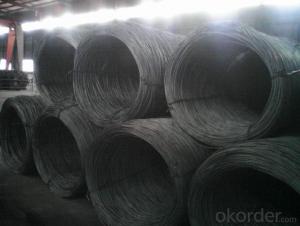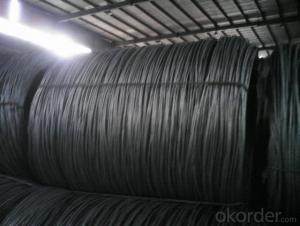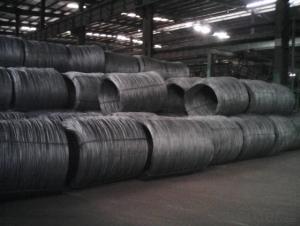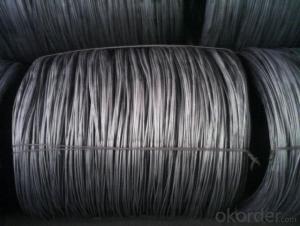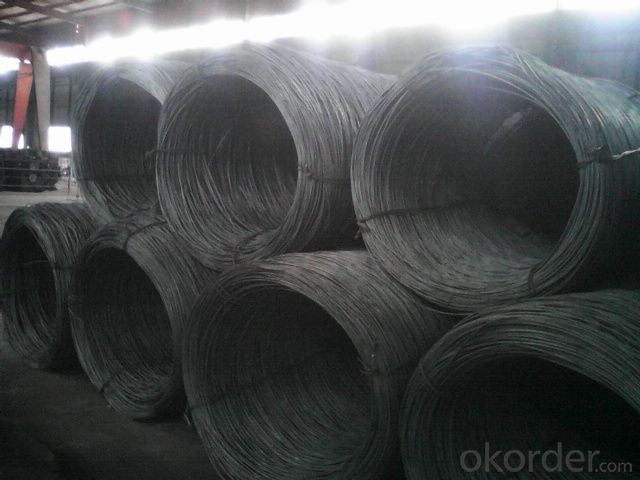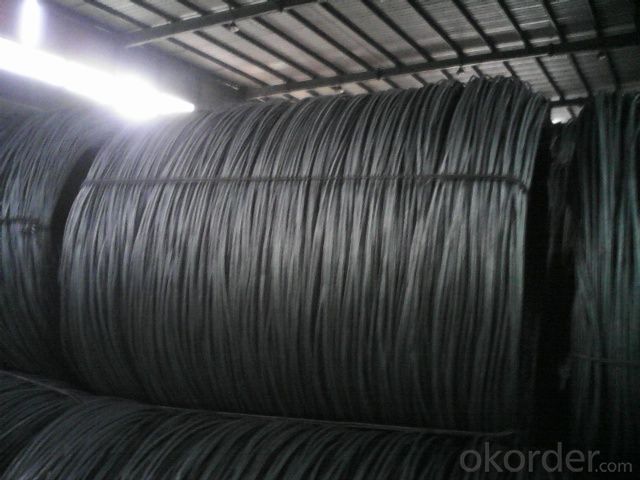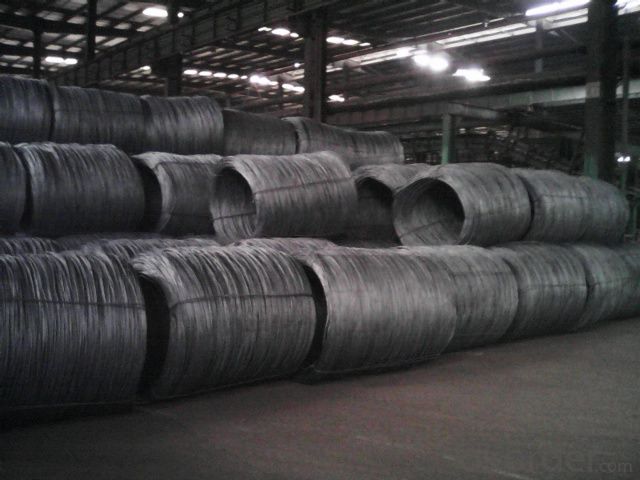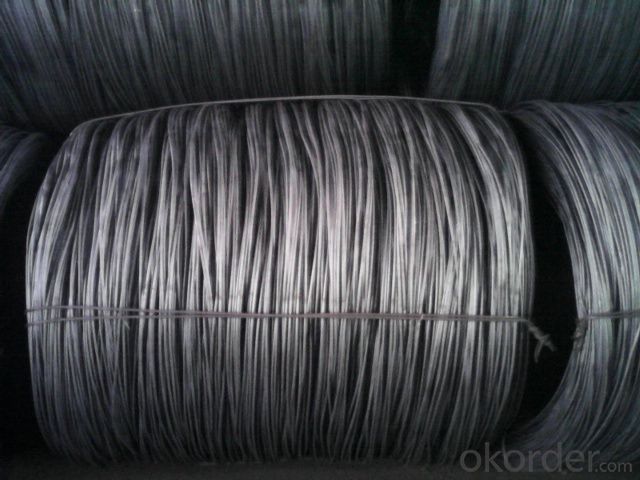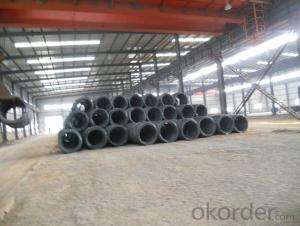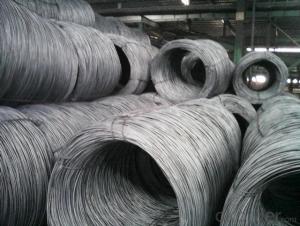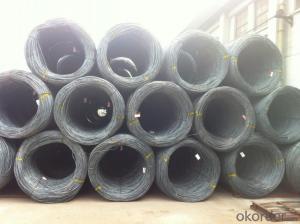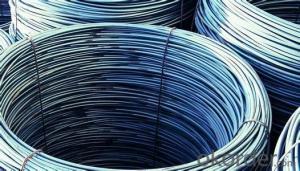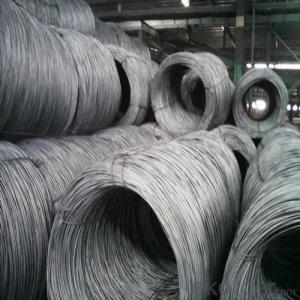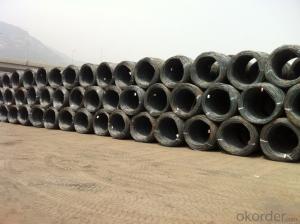Hot Rolled Steel Wire Rod SAE1008 for Constrction
- Loading Port:
- Shanghai
- Payment Terms:
- TT or LC
- Min Order Qty:
- 25 m.t.
- Supply Capability:
- 200000 m.t./month
OKorder Service Pledge
OKorder Financial Service
You Might Also Like
OKorder is offering Hot Rolled Steel Wire Rod SAE1008 for Constrction at great prices with worldwide shipping. Our supplier is a world-class manufacturer of steel, with our products utilized the world over. OKorder annually supplies products to African, South American and Asian markets. We provide quotations within 24 hours of receiving an inquiry and guarantee competitive prices.
Product Applications:
Hot Rolled Steel Wire Rod SAE1008 for Constrction are ideal for structural applications and are widely used in construction and manufacturing. Carbon steel wire rod is mainly used for reinforcement of reinforced concrete and welded structure or reprocessed (roberts , nail, etc.) materials, especially used to produce wire drawing, welding electrode, nails, spring, electronic, precise machinery parts and so on..
Product Advantages:
OKorder's Hot Rolled Steel Wire Rod SAE1008 for Constrction are durable, strong, and wide variety of sizes.
Main Product Features:
· Premium quality
· Prompt delivery & seaworthy packing (30 days after receiving deposit)
· Can be recycled and reused
· Mill test certification
· Professional Service
· Competitive pricing
Product Specifications:
Manufacture: Hot rolled
Grade: Q195 – 235
Certificates: ISO, SGS, BV, CIQ
Length: 6m – 12m, as per customer request
Packaging: Export packing, nude packing, bundled
Grade | Chemical Composition(%) | |||||
C | Mn | Si | S | P | B | |
SAE1006B | 0.03~O.07 | ≤0.32 | ≤0.30 | ≤0.045 | ≤0.040 | >0.0008 |
Mechanical properties | ||||||
Yield strength(N/mm2) | Tensile strength(N/mm2) | Elongation(%) | ||||
250-280 | 350-380 | ≥32 | ||||
Grade | Chemical Composition(%) | |||||
C | Mn | Si | S | P | B | |
SAE1008B | 0.10max | 0.3~O.50 | 0.15max | 0.050max | 0.040 max | 0.0008 min |
Mechanical properties | ||||||
Yield strength(N/mm2) | Tensile strength(N/mm2) | Elongation(%) | ||||
≥195 | 315-430 | ≥30 | ||||
Grade | Chemical Composition(%) | |||||
C | Mn | Si | S | P | B | |
Q195B | 0.06~O.12 | 0.25~O.50 | ≤0.30 | ≤0.050 | ≤0.045 | >0.0008 |
Mechanical properties | ||||||
Yield strength(N/mm2) | Tensile strength(N/mm2) | Elongation(%) | ||||
≥195 | 315-430 | ≥33 | ||||
Grade | Chemical Composition(%) | |||||
C | Mn | Si | S | P | B | |
Q235B | 0.12~O.2 | 0.3~O.701 | ≤0.30 | ≤0.045 | ≤0.045 | >0.0008 |
Mechanical properties | ||||||
Yield strength(N/mm2) | Tensile strength(N/mm2) | Elongation(%) | ||||
235 | 375-500 | ≥26 | ||||
FAQ:
Q1: Why buy Materials & Equipment from OKorder.com?
A1: All products offered byOKorder.com are carefully selected from China's most reliable manufacturing enterprises. Through its ISO certifications, OKorder.com adheres to the highest standards and a commitment to supply chain safety and customer satisfaction.
Q2: How do we guarantee the quality of our products?
A2: We have established an advanced quality management system which conducts strict quality tests at every step, from raw materials to the final product. At the same time, we provide extensive follow-up service assurances as required.
Q3: How soon can we receive the product after purchase?
A3: Within three days of placing an order, we will arrange production. The normal sizes with the normal grade can be produced within one month. The specific shipping date is dependent upon international and government factors, the delivery to international main port about 45-60days.
Images:
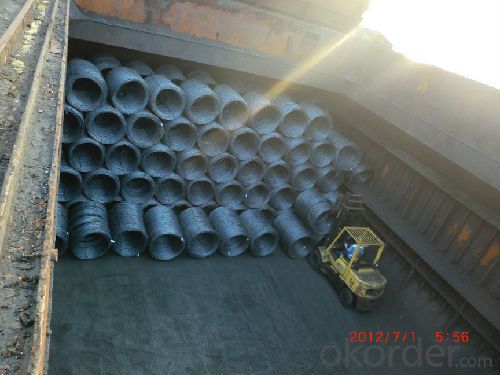
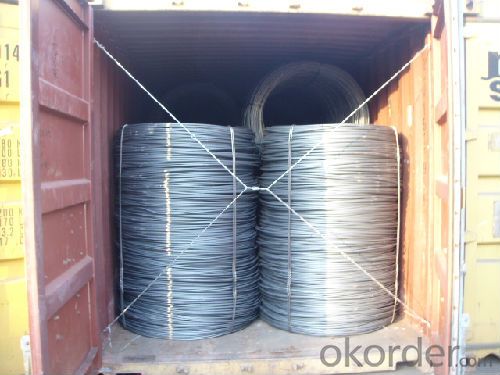
- Q: How is steel wire rod used in the manufacturing of wire forms for wind turbines?
- Steel wire rod is a crucial ingredient in the production process of wire forms used in wind turbines. It acts as the primary material that undergoes several processes to become the final wire forms applied in wind turbine applications. To start with, steel wire rod is chosen for its exceptional strength and durability to endure the harsh environmental conditions and heavy loads encountered by wind turbines. Typically, the wire rod is made of low carbon steel, which offers the desired blend of strength and flexibility. The manufacturing process commences with the wire rod being fed into a wire drawing machine. This machine pulls the wire rod through a sequence of dies, gradually reducing its diameter and increasing its length. This operation, known as wire drawing, enhances the wire's mechanical properties, including tensile strength and surface finish. Once the wire has been drawn to the desired diameter, it is ready for further processing. It may undergo additional treatments like heat treatment or surface coating to enhance its properties. Heat treatment can improve strength and flexibility, while surface coating can provide protection against corrosion and abrasion. After the necessary treatments, the wire is then shaped into the desired form for wind turbine components. This can be accomplished through various methods such as bending, twisting, or welding. These shaping processes are critical in creating wire forms capable of effectively supporting and transmitting the mechanical loads experienced by wind turbines. The wire forms manufactured from steel wire rod find applications in various aspects of wind turbines. They can serve as support structures for the blades, offering stability and strength. Additionally, wire forms are employed as electrical conductors, transmitting power generated by the wind turbine to the electrical grid. In conclusion, steel wire rod plays a vital role in the production of wire forms for wind turbines. Its high strength, durability, and versatility make it an ideal material for withstanding the demanding conditions and loads experienced by wind turbines. Through various processes, the wire rod is transformed into wire forms that act as crucial components in wind turbine construction and operation.
- Q: What are the different types of wire ropes for cranes made from steel wire rod?
- Cranes commonly utilize various types of wire ropes made from steel wire rod. These include: 1. Galvanized Steel Wire Rope: To safeguard against corrosion and rust, this wire rope is coated with zinc. It is frequently used in outdoor and marine settings where exposure to moisture is a concern. 2. Stainless Steel Wire Rope: Made from stainless steel with a higher chromium content, this wire rope is extremely resistant to corrosion. It is suitable for use in harsh environments like chemical plants or offshore installations. 3. Non-Rotating Wire Rope: This wire rope is designed to resist rotation when under load. It consists of multiple layers of wire strands laid in opposite directions to prevent twisting during operation. 4. Compact Wire Rope: Constructed from tightly compacted smaller diameter wires, this wire rope offers increased strength and flexibility. It is ideal for applications with limited space or high breaking load requirements. 5. Plastic Coated Wire Rope: In certain cases, wire ropes are coated with plastic like polyethylene or nylon. This coating offers additional protection against abrasion and wear and can reduce noise and vibration during use. Ultimately, the choice of wire rope depends on the specific requirements of the crane and the operating conditions. Factors such as load capacity, environmental conditions, and the need for rotation resistance all contribute to determining the most suitable wire rope for a particular application.
- Q: How are steel wire rods used in the production of wire coat hangers for hanging clothes?
- Steel wire rods are essential in the production of wire coat hangers for hanging clothes due to their durability and strength. These rods serve as the main material used to create the frame and shape of the coat hangers. Firstly, the steel wire rods are cut into the desired length for the coat hangers. This ensures that each hanger is of the appropriate size for hanging clothes. The rods are then bent and shaped using specialized machinery to form the classic triangular shape that we commonly associate with coat hangers. Next, the ends of the wire rods are smoothed and rounded off to prevent any sharp edges that could potentially damage the clothing. This step is crucial to ensure that the hangers are safe to use and won't cause any harm to the clothes being hung. Once the wire rods have been shaped and smoothed, they are coated with a protective layer, usually made of plastic or rubber. This coating serves multiple purposes. Firstly, it prevents the steel rods from rusting or corroding over time, ensuring the longevity of the coat hangers. Additionally, the coating provides a non-slip surface that helps prevent clothes from sliding off the hanger. Finally, the coated wire rods are attached to a hook at the top, which allows the hangers to be hung on a closet rod or any other suitable hanging mechanism. This hook is usually made of a separate material, such as plastic or metal, and is securely attached to the wire rod to ensure the stability and functionality of the coat hanger. Overall, steel wire rods play a vital role in the production of wire coat hangers by providing the strength, durability, and shape necessary for hanging clothes. Their versatility and ability to be shaped and coated make them an ideal material for creating reliable and long-lasting coat hangers.
- Q: What are the main factors influencing the choice of steel wire rod order payment method?
- The selection of the payment method for steel wire rod orders can vary based on the specific circumstances and preferences of the parties involved. However, there are common factors that typically play a role, including: 1. Transaction volume and frequency: If the buyer and seller have a long-term and high-volume relationship, they may choose a more convenient and efficient payment method, such as open account or letter of credit. This eliminates repetitive paperwork and bank involvement, ensuring smoother and quicker transactions. 2. Trust and creditworthiness: If there is a lack of trust between the buyer and seller, or if the buyer's creditworthiness is questionable, the seller may prefer more secure payment methods like advance payment or documentary collection. These methods provide assurance that payment will be made before the goods are delivered. 3. Cost and convenience: The cost and convenience of different payment methods can also affect the decision. For example, if the buyer wants to avoid additional fees or charges associated with certain payment methods, they may choose cash in advance or electronic funds transfer. Conversely, if the seller wants to minimize administrative burden or payment processing costs, they may prefer open account or electronic payments. 4. Country-specific regulations and customs: Each country has its own regulations and customs regarding international trade and payment methods. For instance, certain countries may restrict certain payment methods or require specific documentation for customs clearance. Sellers and buyers must consider these factors when selecting a payment method. 5. Payment security and risk mitigation: The desired level of payment security and risk mitigation by the buyer and seller can also influence the choice of payment method. Methods like letter of credit or documentary collection offer higher security and risk mitigation compared to open account or cash in advance. 6. Market norms and industry practices: Prevailing market norms and industry practices can also impact the selection of payment methods. In some industries or regions, specific payment methods may be commonly used due to historical practices or preferences. In conclusion, the main factors influencing the choice of payment method for steel wire rod orders include transaction volume and frequency, trust and creditworthiness, cost and convenience, country-specific regulations and customs, payment security and risk mitigation, as well as market norms and industry practices. It is crucial for both the buyer and seller to carefully evaluate these factors in order to select the most suitable payment method for their specific situation.
- Q: What are the different types of steel wire rod surface finishes after wire drawing?
- There are several types of steel wire rod surface finishes that can be achieved after wire drawing. These include bright finish, black finish, galvanized finish, and coated finish. The bright finish is achieved by polishing the wire rod, resulting in a shiny and smooth surface. The black finish is obtained through a process called annealing, which involves heating the wire rod to a high temperature and then cooling it slowly, resulting in a darkened surface. The galvanized finish is achieved by applying a layer of zinc coating to the wire rod, providing protection against corrosion. Lastly, the coated finish involves applying a layer of specialized coating, such as PVC or nylon, to the wire rod for specific applications or enhanced properties.
- Q: What are the common welding techniques for steel wire rod?
- Different welding techniques are used for steel wire rods depending on the specific application and desired outcome. Some commonly used techniques include: 1. Gas Metal Arc Welding (GMAW), also known as MIG welding, utilizes a consumable wire electrode and shielding gas to create a weld. GMAW is popular for its versatility, ease of use, and ability to produce high-quality welds when working with steel wire rods. 2. Gas Tungsten Arc Welding (GTAW), also known as TIG welding, involves a non-consumable tungsten electrode and shielding gas to create a weld. GTAW is often employed for precision welding applications that require precise control and a visually appealing weld. 3. Flux-Cored Arc Welding (FCAW) uses a tubular wire electrode with a flux-filled core. The flux serves as a shielding gas and aids in removing impurities from the weld zone. FCAW is suitable for welding steel wire rods outdoors or in windy environments where the shielding gas of GMAW or GTAW may be compromised. 4. Shielded Metal Arc Welding (SMAW), also known as stick welding, employs a consumable electrode coated in flux. The flux generates a shielding gas and assists in removing impurities from the weld zone. SMAW is a versatile and portable welding technique commonly used for steel wire rods in various applications. 5. Resistance Welding involves passing an electric current through the steel wire rods to create resistance and generate heat, fusing the materials together. Resistance welding is commonly utilized for high-speed production welding of steel wire rods, such as in the manufacturing of wire mesh or fences. It is crucial to select the appropriate welding technique based on factors such as the type of steel wire rod, desired weld strength and quality, welding environment, and available equipment and resources.
- Q: What are the different types of steel wire rod drawing machines?
- There are several types of steel wire rod drawing machines, including single block, multiple block, and continuous drawing machines. Single block machines have one drawing block that pulls the wire through a die to reduce its diameter. Multiple block machines have several drawing blocks in series, each reducing the wire diameter further. Continuous drawing machines have multiple drawing blocks arranged in a loop, allowing for continuous operation and greater reduction in wire diameter.
- Q: What are the common production processes for titanium-coated steel wire rod?
- The common production processes for titanium-coated steel wire rod include cleaning and pre-treatment of the steel wire, application of a titanium coating through a physical vapor deposition or electroplating process, curing or drying of the coating, and final inspection and packaging of the coated wire rod.
- Q: What are the main factors influencing the choice of steel wire rod delivery time?
- There are several key factors that influence the choice of steel wire rod delivery time. Firstly, the availability of raw materials plays a significant role. The production of steel wire rods requires various raw materials such as iron ore, coal, and scrap metal. The availability and accessibility of these materials can impact the production process and ultimately affect the delivery time. Secondly, the overall demand for steel wire rods in the market is an important factor. If there is high demand for steel wire rods, the production and delivery time may be longer due to increased order volumes. Conversely, if demand is low, suppliers may be able to deliver the product more quickly. Thirdly, the production capacity of the steel mill or manufacturer is a crucial factor. If the steel mill has limited capacity or is running at full capacity, it may take longer to fulfill orders and deliver the wire rods. On the other hand, if the production capacity is high, the delivery time may be shorter. Additionally, logistical factors such as transportation and shipping can also impact the delivery time of steel wire rods. If there are delays or disruptions in the transportation network, it may prolong the delivery process. Moreover, the distance between the steel mill and the customer's location can affect the delivery time as well. Lastly, external factors like weather conditions, labor strikes, or unforeseen events can also influence the choice of steel wire rod delivery time. These factors may cause disruptions in the production process and affect the overall delivery timeline. In conclusion, the main factors influencing the choice of steel wire rod delivery time include the availability of raw materials, market demand, production capacity, logistical factors, and external events. It is essential for manufacturers and customers to consider these factors when planning for the delivery of steel wire rods.
- Q: What are the main factors influencing the choice of steel wire rod storage conditions?
- There are several main factors that influence the choice of steel wire rod storage conditions. These factors include the type and quality of the steel wire rod, the intended use or application of the rod, environmental conditions, and safety considerations. Firstly, the type and quality of the steel wire rod play a significant role in determining the storage conditions. Different types of steel wire rods may have specific requirements for temperature, humidity, and exposure to elements. For instance, corrosion-resistant steel wire rods may require controlled humidity levels to prevent rusting, while high carbon steel wire rods may require specific temperature conditions to maintain their mechanical properties. The intended use or application of the steel wire rod is another crucial factor. Some wire rods may be used in sensitive industries such as aerospace or automotive, where strict storage conditions are necessary to maintain the desired properties of the rod. On the other hand, if the wire rod is intended for general use or non-critical applications, the storage conditions may be more flexible. Environmental conditions also impact the choice of storage conditions. Factors such as temperature, humidity, and exposure to sunlight can affect the quality and durability of steel wire rods. For example, extreme heat or cold can cause expansion or contraction, potentially leading to deformation or breakage. Similarly, high humidity levels can promote corrosion, while excessive exposure to sunlight can lead to discoloration or degradation of the rod. Lastly, safety considerations are vital when determining the storage conditions for steel wire rods. Some wire rods may be hazardous or flammable, requiring special storage arrangements to ensure the safety of personnel and the surrounding environment. Additionally, proper handling and storage practices, such as securing the rods to prevent accidental falls or collisions, should be considered to avoid damage or injury. In conclusion, the main factors influencing the choice of steel wire rod storage conditions include the type and quality of the rod, its intended use, environmental conditions, and safety considerations. By taking these factors into account, one can ensure the optimal storage conditions for steel wire rods, thereby preserving their quality and ensuring their suitability for the intended applications.
Send your message to us
Hot Rolled Steel Wire Rod SAE1008 for Constrction
- Loading Port:
- Shanghai
- Payment Terms:
- TT or LC
- Min Order Qty:
- 25 m.t.
- Supply Capability:
- 200000 m.t./month
OKorder Service Pledge
OKorder Financial Service
Similar products
Hot products
Hot Searches
Related keywords
